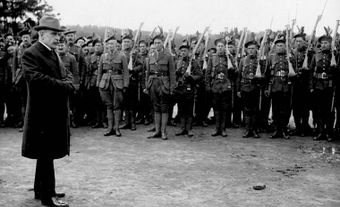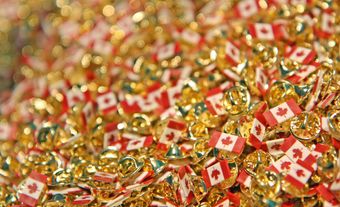
Background
From the time of Confederation, Canada was unwilling formally to organize naval forces, even though British legislation encouraged the colonies to do so in 1865. One of the reasons why Britain supported Confederation was to allow the expensive British army garrisons that protected the border to withdraw and leave land defence to the Canadian militia. During this period, Canadian security depended on the strength of the British Royal Navy, and Canadian leaders feared that if they organized a local naval force the British would withdraw warships from Canadian waters for service elsewhere.
At the same time, the Canadian government worried that Britain would take control of any naval force the Dominion might organize. The pressing issue was American fishermen encroaching on territorial waters off Canada’s Atlantic coast, which extended 3 nautical miles (approximately 6 km) from shore. One reason why the federal government promptly established the Department of Marine and Fisheries was to protect valuable fish resources. Government vessels manned by civilian crews and carrying light armaments arrested American vessels that violated the 3-mile limit.
Canada rejected British advice that fisheries protection craft be commissioned as naval vessels for fear that the Royal Navy, exercising the British government’s strong desire not to alienate the United States, would take command of the ships and prevent effective action against American craft. Canadian stubbornness in the late 1860s brought the desired result. The British government instructed Royal Navy warships based at Halifax to assist the Canadian vessels in enforcement, an effort to ensure that treatment of American ships was carefully and correctly carried out and thereby give the Americans the least possible reason to protest.
Creation of the Canadian Navy
During the late 19th century, both Canadian and British officials proposed that Canadian vessels protecting fisheries could be turned into a naval organization. The proposals suggested that the civilian crews be given military training and that fisheries protection vessels be fitted with naval guns in order to act as a coastal defence force in wartime, thus relieving pressure on the overstretched Royal Navy.
Nothing happened until Canada and other dominions contributed to the British army in the South African War (1899–1902), which increased pressure from Britain to form a permanent system of imperial defence cooperation, including naval as well as land forces. Facing deep divisions between pro- and anti-imperialist sentiment in the country, Prime Minister Sir Wilfrid Laurier compromised by promising to develop more capable national Canadian armed forces that could help Britain in a crisis, but only if the Canadian Parliament agreed to provide assistance.
In 1904, the minister of Marine and Fisheries, Raymond Préfontaine, prepared the Naval Militia Bill, which provided for a permanent naval force of 800 personnel within the Department of Marine and Fisheries. They would be specially trained crew members aboard government ships and also serve as instructors for civilian seamen enrolled for part-time service on the model of the land militia. Nothing came of the bill after Préfontaine’s death in 1905.
Starting in 1903, the Fisheries Protection Service procured improved ships and stronger armament. More important still, the marine and fisheries department took over the Royal Navy’s substantial bases at Halifax and Esquimalt, British Columbia. Both bases were abandoned by the British in 1906, when they concentrated their fleet strength in European waters. Canada agreed to assume the defence of both bases. In 1908, the government recruited Rear Admiral Charles E. Kingsmill, a Canadian who retired after nearly 40 years’ service in the Royal Navy, as director of the marine and fisheries fleet to increase the professionalism of the crews and operations.
In 1909, panic in Britain over acceleration of Germany’s naval expansion, which threatened to overtake the Royal Navy in numbers of the most powerful battleships, immediately spread to Canada, Australia and New Zealand. There were widespread calls from the public in all three dominions to provide special money grants to the Royal Navy to accelerate its battleship building program.
Naval Services Act
Compelled to take action, the Laurier government initially intended to improve the naval capabilities of the Marine and Fisheries fleet, including the procurement of small coastal warships. At the special Imperial Defence Conference called by Britain in summer 1909, all the dominions’ representatives were surprised that the British Admiralty urged the dominions not to give money. Instead, the British Admiralty urged them to organize substantial seagoing navies, “fleet units” built around a dreadnought battle cruiser, one of the largest and most powerful modern warships. Louis-Phillippe Brodeur, the minister of Marine and Fisheries, rejected the acquisition of such a costly ship, which could serve on only one of Canada’s two main coasts. The Admiralty therefore recommended that Canada procure four or five light cruisers (much smaller than a battle cruiser, but capable of high seas operations) and six coastal-defence destroyers, a force that could protect Canada’s shores and also support the Royal Navy on the high seas.
In order to carry out this program, the government introduced the Naval Service Bill in the House of Commons on 12 January 1910, which was passed after intense debate by the Liberal majority. The Act received royal assent on 4 May 1910 and authorized the creation of the Department of the Naval Service, a permanent naval force of full-time personnel and the establishment of a naval college to develop Canadian professional officers.
The Act had other nationalist provisions. Canadian ships could be assigned to British command only with the specific approval of the government, and Parliament had immediately to authorize the government’s action. The minister of Marine and Fisheries was to double as minister of the new navy department, thus preserving the traditional Canadian link between civilian administration of maritime resources and defence.
Admiral Kingsmill was appointed director of the Naval Service — the professional head of the navy — and key parts of the Department of Marine and Fisheries with defence-related functions, such as the Fisheries Protection Service, were transferred to the navy department. Canada purchased two British cruisers crewed by experienced Royal Navy personnel who taught Canadian recruits. Before the ships arrived at their new homes in the fall of 1910 — Niobe in Halifax and Rainbow in Esquimalt — they were recommissioned as His Majesty’s Canadian Ships. Meanwhile, the government began to make arrangements to build the modern cruisers and destroyers recommended by the Admiralty.
On 16 August 1911, the British government sent word that King George V gave his permission to rename the Naval Service of Canada as the Royal Canadian Navy.
Criticism, Cutbacks and the First World War
Supporters of the British Empire thought the Naval Service Act did too little to help the Royal Navy, and anti-imperialists — the most vocal of whom was Henri Bourassa in Québec — believed the very existence of the navy would drag the country into every British conflict, however remote from Canada.
Robert Borden, leader of the Conservative Opposition, capitalized on such growing unpopularity and used it to unseat the Laurier Liberals in the election of 1911. Once elected, Borden cancelled the program to build new warships and cut the navy department budget to bare maintenance of the existing skeleton force. His main initiative, the Naval Aid Bill of 1912–13, was to give direct aid to the Royal Navy by a grant of $35 million, which could be used to build three large battleships. However, the bill was defeated by the Liberal majority in the Senate. Before Borden could find an alternate policy, the First World War broke out in August 1914.
As the Germans turned to submarine warfare in 1915, Britain admitted that the cruisers had to be supplemented by small, anti-submarine warships, which the Royal Navy could not supply. Thus, the Royal Canadian Navy expanded to some 9,500 personnel during the war, including crews to operate anti-submarine vessels built in Canada and also civilian steamers fitted with anti-submarine equipment. The key vessels and experienced personnel came from the Fisheries Protection Service (see U-boat Operations).
Convinced of the need for a Canadian navy, Borden never revised the Naval Service Act, which was used to reorganize the navy after the First World War. With only minor changes resulting from the integration of the Department of the Naval Service into the new Department of National Defence in 1922, the Naval Service Act continued in force until 1944, when it was revised to reflect Canada’s increased autonomy from Britain. Those changes were passed by Parliament as The Naval Service Act, 1944. The main provisions for the organization and operation of the navy, however, remained much as they had been in 1910. The Act was superseded in 1950 by the National Defence Act, which became the legal basis for all three armed services: the Canadian Army, the Royal Canadian Navy and the Royal Canadian Air Force. This was also the first legislation to replace the original term Naval Service of Canada with Royal Canadian Navy, the name by which the navy had been universally known since King George V approved it in 1911.

 Share on Facebook
Share on Facebook Share on X
Share on X Share by Email
Share by Email Share on Google Classroom
Share on Google Classroom


